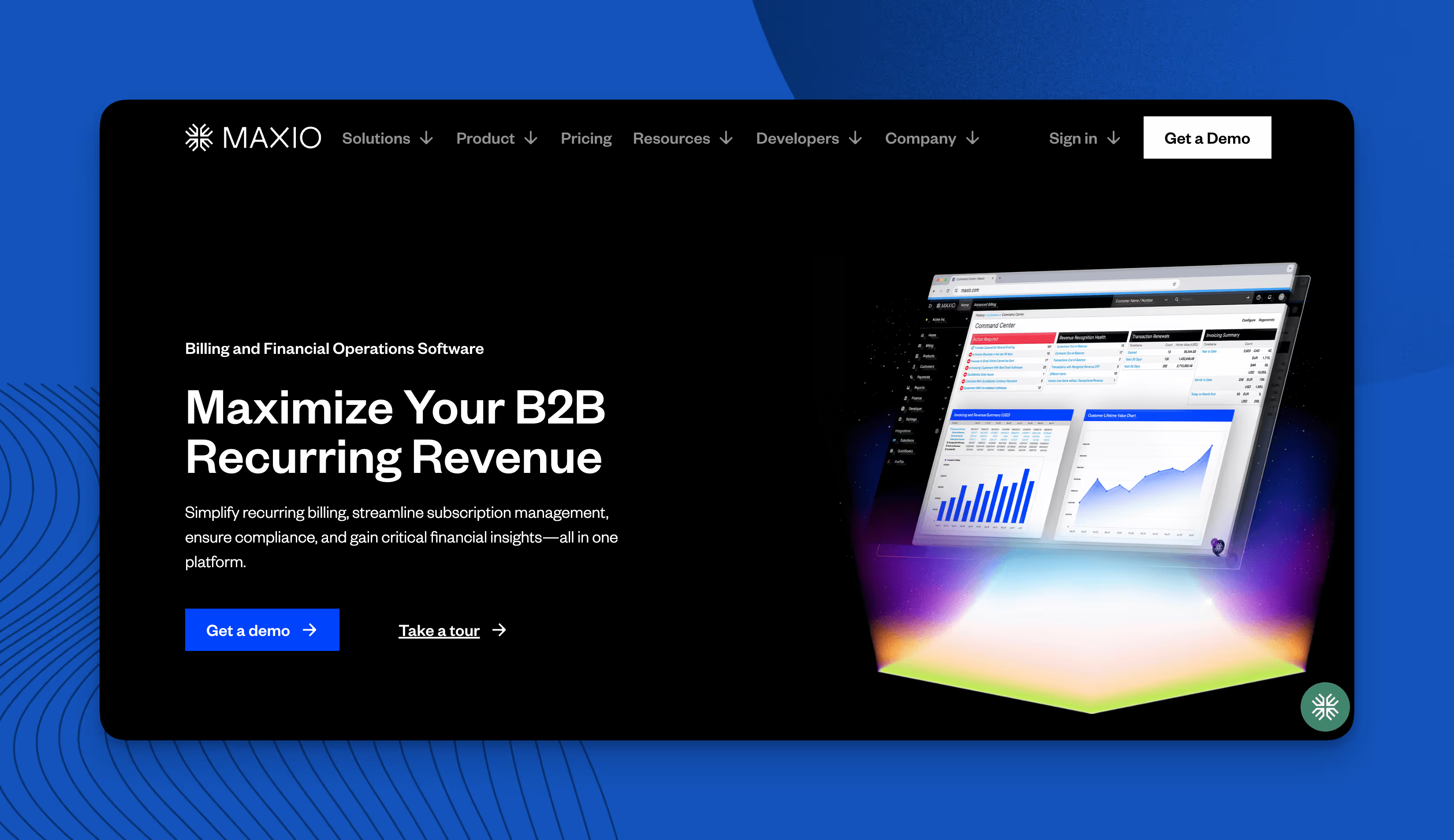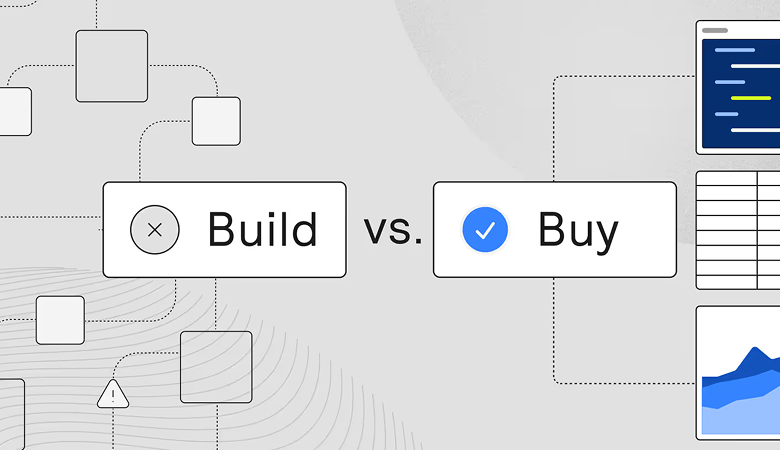Is Maxio the right billing management platform for your SaaS company?
In this blog post, we’ll take a deep dive into Maxio’s offerings. We’ll look at the pros and cons and let you know who should use Maxio and who should stay away from it.
In this Maxio review, we’ll go over:
- A TL;DR list and comparative chart of Maxio alternatives
- An overview of Maxio as a platform
- Key offerings and pricing at every tier
- Pros and cons, along with actual reviews left by users
- Who might find it helpful (and who might not)
Let’s get started by sharing a quick comparative chart and then explaining what Maxio is.
Maxio alternatives summarized and comparative chart

Here’s a TL;DR list of Maxio alternatives you should consider:
- Orb: The top choice for usage-based billing, Orb is easy to use and provides in-depth invoices.
- Chargebee: User-friendly with transparent pricing, Chargebee is suitable for simple subscription management.
- Recurly: Designed for developers, Recurly is customizable and handles complex subscription scenarios.
- Stripe: A versatile platform that handles payments and subscriptions. A solid option for businesses seeking a unified solution.
Please note: The prices shown in the chart below are current as of the time of publishing in December 2024, and these costs can change. For the latest info on fees, go to the respective websites of each company.
To save you time, we’ve also created a comparative chart:
For a more detailed look at these, read our full article comparing Maxio with its main competitors.
A review of what Maxio is and what it does
Before diving into Maxio’s features, let’s first answer the question, “What is Maxio?”
Maxio is a billing and financial operations platform designed for B2B SaaS businesses. It aims to automate and simplify complex billing processes. Maxio allows companies to focus on growth and innovation rather than chasing payments.
To get a more solid grasp on what Maxio is and what it can do, let’s inspect its offerings more closely:
Maxio features
- Subscription management: Maxio allows businesses to create and manage various subscription plans, including free trials, discounts, coupons, add-ons, and upgrades/downgrades.
- Payment processing: Maxio integrates with many payment gateways, providing a seamless checkout experience. It also accepts various payment methods when handling recurring billing.
- Dunning management: The platform helps recover failed payments. It does so through automated dunning emails and retries.
- Revenue recognition: Maxio automates revenue recognition. It complies with ASC 606 and IFRS 15 accounting standards.
- Analytics and reporting: Maxio provides detailed reports and dashboards to track key SaaS metrics, such as MRR, ARR, churn, LTV, and more.
- Integrations: Maxio connects with your CRM and accounting software for a frictionless workflow.
Maxio pricing
Maxio offers a tiered pricing structure designed to accommodate the needs of businesses at various stages of growth. Let’s take a closer look:
Build plan
It’s free for 30 days and is ideal for those looking to test Maxio in a sandbox environment. It includes features such as support for both fixed and usage-based billing, product catalog management, and subscription and customer management
It also includes API access and basic integrations with CRM and payment gateways.
Grow plan
It’s priced at $599 per month for up to $100,000 in monthly billing volume. It expands on the Build plan with a suite of tools tailored for B2B subscription management.
This plan supports automated revenue recognition, contract term management, and advanced SaaS metrics, complete with customizable dashboards and one-click financial reporting. Users also gain access to Maxio Payments for streamlined payment handling.
Scale plan
The Scale plan offers custom pricing tailored to companies with high billing volumes. This plan builds on the Grow plan, supporting features such as advanced revenue recognition, multi-entity support, and expense amortization.
It also provides options for milestone-based billing and comprehensive accounts receivable management. Volume-based discounts are available for businesses with significant billing needs.
Note: For the most up-to-date details on features and pricing, refer to Maxio’s official pricing page.
Maxio pros
Let’s examine what users like and hate about using Maxio daily. Let’s start with the pros:
- Complex contract handling: Maxio easily handles intricate billing agreements. Users praise its ability to manage complex contract schedules and bill according to individual terms. Maxio software provides solutions that simplify invoicing.
A user praised them saying: “Maxio streamlines our complex E2E invoicing and revenue recognition.”
- Revenue recognition: Maxio users say its revenue recognition features are a standout benefit. The platform simplifies this often complex process, ensuring compliance with accounting standards (GAAP).
Speaking of GAAP, one user said: “It gives us confidence that our SaaS revenue recognition is correct and meets the GAAP standards. Its monthly journal entries are easy to enter into QuickBooks. Its built-in reports provide good visibility into our revenue, growth, attrition, and other metrics.”
- Customizable billing workflows: Maxio can tailor invoicing workflows to suit specific business needs for recurring or usage-based billing. This level of customization is valuable for businesses with unique or evolving billing processes, and users praise it.
This is what one user had to say about Maxio billing: “Integration with Salesforce makes it easy for reps to close deals without great workflow burdens. Subscription momentum reports make it easy to build live models and forecasts.”
- Reporting and analytics: Maxio's software provides insights into your financial performance. Yet, some users in Maxio reviews find the reporting interface to be less intuitive.
It really is a mixed bag, as a user said: “We especially value its automatic dunning system, the main dashboard for ARR reporting.” However, he later on added: “The reporting function has room for improvement to enhance its utility.”
Maxio cons
Maxio reviews show many disgruntled users who aren’t happy with Maxio. Some even go as far as to say it’s one of the worst experiences they’ve ever had with a partner.
Let’s look at some of the cons and set the record straight:
- Confusing reporting: Some users find Maxio’s interface and data organization difficult to navigate. Generating specific reports or extracting desired insights can be a challenge.
One user even said: “After using them for years, we realized that the churn rates and MRR metrics they reported on our dashboard were completely wrong and far from our reality. Because of this we misinterpreted our business performances for years!”
- Occasional revenue-recognition hiccups: Numerous Maxio reviews reported users experienced issues with accuracy and granularity. This happens especially with complex contracts or edge cases.
For instance, a reviewer expressed: “With how our current product structure and our contract structures are so dependent on customer customization, that revenue recognition and ARR/MRR calculations with differing amounts of revenue recognized in any given month do not work well with the standard Maxio reports.”
- Steep learning curve: Users often mention Maxio’s steep learning curve. Its feature set and complex functionalities can be overwhelming, especially for non-technical users.
This has led to very long (10-month) onboarding processes. In fact, that very same user said it was “10 months of an onboarding nightmare”. They went on to add: “We are a small company, and the onboarding process took over 10 months to complete.”
- Unreliable customer support: Many users have expressed dissatisfaction with Maxio's customer support. Some issues include long response times, limited availability, and difficulty reaching support.
A reviewer said the following about what they disliked about Maxio: “So many things...The biggest issue is that we brought a revenue reporting issue to their attention, and in 3 weeks it still has not been addressed. Their support refuses to get on the phone, and there is no path to escalation.”
- Scalability issues: Some users claim Maxio isn't as scalable as other solutions. This is a big problem for growing businesses with increasing billing complexity.
On that note, a reviewer said: “The platform is so big, and our business is so small comparatively that it seems like we're not using even half of the platform's capabilities. Also, because there are so many functions, it's easy to make a mistake.”
Is Maxio right for you?
If you’re still wondering what Maxio is good for and whether it’s the right choice for you, pinpointing its strengths and limitations will help determine if it meets your company's needs. Here’s a short summary to help you make the right choice:
Who Maxio is good for
- Businesses with complex billing needs: Does your company have intricate contracts? Maxio's features can be valuable, particularly if you're working with diverse pricing models.
- Companies prioritizing revenue recognition: Maxio's strength lies in its revenue recognition capabilities. This makes it a good fit for businesses with stringent financial reporting requirements and those who need to adhere to GAAP standards.
- Teams with finance expertise: Does your team have experience with complex financial software? Would they be okay with a bit of a learning curve? Maxio's comprehensive feature set could be a valuable asset.
Who should avoid Maxio
- Smaller businesses with more straightforward needs: Maxio might be overkill if you have a small business with simple billing. The complexity and cost might not be justified for your current needs.
- Non-technical teams: Does your team lack technical expertise? If so, Maxio's interface and setup could be challenging. You might be better off with a more user-friendly platform like Orb or Recurly.
- Businesses on a tight budget: Maxio's pricing can be a roadblock for companies with limited budgets. More affordable alternatives, such as Orb, are available.
- Companies needing quick and responsive support: Maxio's customer support isn't the best. Users often criticize it for its slow response times and limited availability. If readily available support is crucial for your operations, you might want to explore other options.
- Businesses seeking usage-based billing: Maxio can handle usage-based billing. Still, it isn't as intuitive or streamlined as dedicated as purpose-built usage-based billing platforms like Orb.
Ready to solve billing?

Now that you’ve read our Maxio review, you should have a clearer idea of what Maxio is. You should also be able to determine whether it’s the right billing management platform for you.
If you’ve decided to look for superior options, you should consider Orb, a more suitable alternative for all your billing needs.
Orb is a powerful billing management platform for highly complex usage-based and hybrid billing models. These are just a few of the fronts on which Orb beats Maxio:
- Better event ingestion and scale: Orb can handle a larger volume of event ingestion than Maxio. This makes it a better choice for organizations with higher transaction volumes and those basing their charges on usage metrics.
- Accurate invoicing: Orb lets companies create invoices with decimal points. This is a vital feature for businesses that use APIs and charge fractions of dollars. These levels of granularity are nowhere to be found with Maxio.
- Unmatched reports and tracking capabilities: Unlike Maxio, Orb gives businesses more detailed tracking. Sophisticated billing insights are also included. This feature gives companies a clearer view of their billing processes and customer usage patterns.
Still unsure about Orb? Try out our demo and see how we can solve billing for you.



